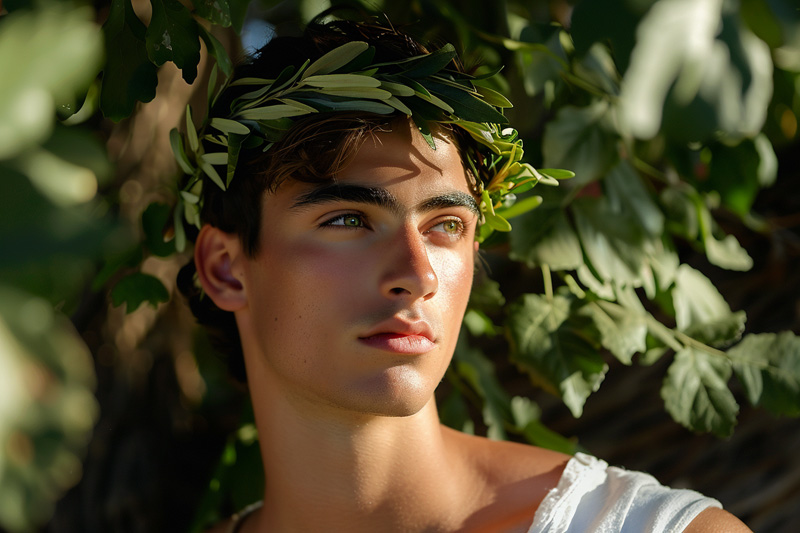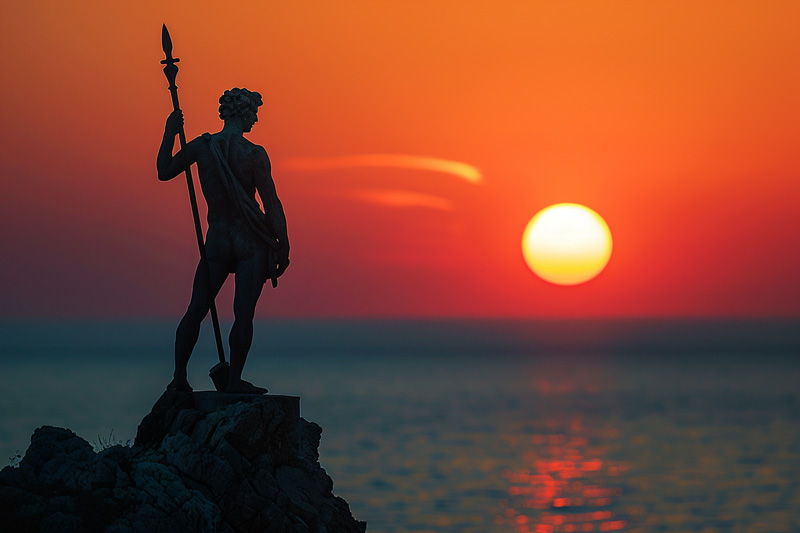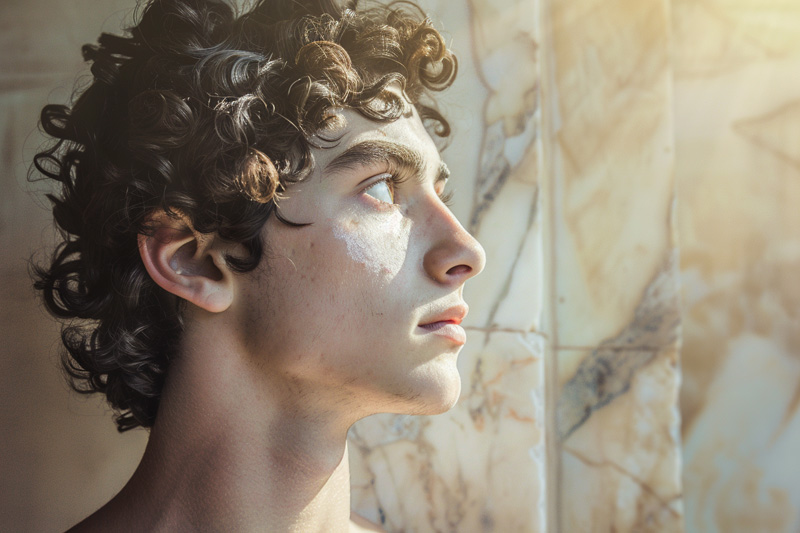KidZone Geography: Greek Mythology
About Apollo, God of the Sun and Music
Introduction to Apollo
Apollo, one of the twelve Olympian deities in Greek mythology, is the god of the sun, music, poetry, prophecy, and healing. Known for his beauty and artistic talents, Apollo is a multifaceted god with influence over many aspects of life and culture. Often depicted with a lyre and a laurel wreath, Apollo embodies harmony, enlightenment, and the pursuit of knowledge.

Quick Facts About Apollo
What is Apollo the Greek god of? Apollo is the Greek god of the sun, music, poetry, prophecy, and healing. He governs the arts and serves as a symbol of intellectual and spiritual enlightenment.
What are Apollo's sacred animals? Apollo's sacred animals include the swan, the raven, and the python. The swan symbolizes grace and beauty, the raven represents prophecy, and the python is linked to his victory over the Python serpent at Delphi.
What are Apollo's symbols? Apollo's primary symbols are the lyre, the laurel wreath, and the sun chariot. The lyre represents music and arts, the laurel wreath symbolizes victory and honor, and the sun chariot signifies his role as the bringer of light.
Origins and Birth
Birth on Delos
Apollo is the son of Zeus and Leto. Hera, jealous of Leto, forbade her from giving birth on solid ground. Leto found refuge on the floating island of Delos, where she gave birth to Apollo and his twin sister, Artemis. Apollo's birth was celebrated by the gods, and he quickly grew to adulthood.
Apollo's Role in Greek Mythology

God of the Sun and Music
Apollo's primary roles are as the god of the sun and music. He drives the sun chariot across the sky, bringing light to the world. As the god of music, he is often depicted with a lyre, an instrument he was gifted by Hermes. Apollo's music symbolizes harmony and the arts, and he is often seen inspiring creativity and intellectual pursuits.
God of Prophecy and Healing
Apollo is also the god of prophecy, and his oracle at Delphi was one of the most important in the ancient world. People from all over Greece came to consult the Pythia, the priestess of Apollo, for guidance. Additionally, Apollo is associated with healing, and he was invoked for protection against diseases and to aid in recovery.
Iconography and Symbols
The Lyre
The lyre is Apollo's most recognizable symbol, representing his mastery over music and the arts. It is often depicted in his hands as he plays and inspires creativity.
The Laurel Wreath
The laurel wreath symbolizes victory and honor, stemming from the myth of Daphne. After being pursued by Apollo, Daphne was transformed into a laurel tree to escape him. Apollo then adopted the laurel as his sacred plant, wearing its wreath as a symbol of triumph.
The Sun Chariot
The sun chariot represents Apollo's role as the bringer of light. Each day, he drives the chariot across the sky, illuminating the world and symbolizing the cycle of day and night.
Major Myths Involving Apollo
The Slaying of Python
One of Apollo's most famous myths is his slaying of Python, a serpent that guarded the oracle at Delphi. After defeating Python, Apollo claimed the oracle as his own, establishing his role as the god of prophecy.
The Love of Daphne
Apollo's unrequited love for Daphne is another well-known myth. Struck by Eros's arrow, Apollo fell deeply in love with Daphne, who rejected his advances. To escape him, she prayed to her father, who transformed her into a laurel tree. Apollo then made the laurel his sacred plant, honoring her forever.
The Tale of Hyacinthus
Apollo also had a tragic love affair with Hyacinthus, a mortal youth. While playing discus, Apollo accidentally struck Hyacinthus, killing him. From Hyacinthus's blood, Apollo created the hyacinth flower, immortalizing his beloved.
Apollo's Relationships and Offspring
Relationships with Muses and Mortals
Apollo had numerous relationships with both goddesses and mortals. Among his lovers were the Muses, who inspired the arts and sciences, and mortal women such as Coronis and Calliope.
Divine and Mortal Offspring
Apollo's children played significant roles in various myths and legends. Some of his notable offspring include:
- Asclepius: The god of medicine and healing, born to Apollo and Coronis.
- Orpheus: A legendary musician and poet, son of Apollo and the Muse Calliope.
- Troilus: A Trojan prince whose fate was tied to the outcome of the Trojan War.
Worship and Cult of Apollo

Temples and Sanctuaries
Apollo was worshipped throughout ancient Greece, with many temples and sanctuaries dedicated to him. The most famous of these is the Temple of Apollo at Delphi, which housed the oracle and was a major religious center. Another significant site is the Temple of Apollo at Delos, his birthplace.
Festivals and Rituals
Several festivals celebrated Apollo's influence over the arts, prophecy, and healing. The most notable of these is the Pythian Games, held every four years at Delphi in his honor. These games included athletic competitions, musical contests, and sacrifices. The Delia, held on Delos, celebrated Apollo's birth with music, dance, and athletic events.
Apollo in Art and Literature

Classical Depictions
In classical art, Apollo is often depicted as a handsome, youthful figure with a lyre and laurel wreath. These representations emphasize his beauty and his association with music and arts.
Renaissance and Beyond
During the Renaissance, artists like Michelangelo and Raphael drew inspiration from classical depictions of Apollo, incorporating him into their works. Raphael's frescoes, for example, often depict Apollo as an idealized figure of beauty and harmony.
Modern Interpretations
In modern times, Apollo continues to be a prominent figure in literature, film, and popular culture. He appears in various forms, from comic books and movies to television series and video games. These contemporary portrayals often explore different aspects of his character, from his intellectual pursuits to his romantic entanglements. In the Percy Jackson series, for example, Apollo is depicted as a charismatic and multi-talented god, reflecting modern interpretations of his myth.
Conclusion
Apollo remains one of the most dynamic figures in Greek mythology. His role as the god of the sun, music, poetry, prophecy, and healing, combined with his complex personality and significant myths, make him a fascinating character. As the embodiment of light, knowledge, and artistic inspiration, Apollo's influence extends across the divine and mortal realms. His enduring impact can be seen in the continued fascination with his myths and the artistic representations that keep his legend alive. Through his worship, iconography, and the rich tapestry of stories that surround him, Apollo exemplifies the brilliance and complexity of ancient Greek religion and mythology.

